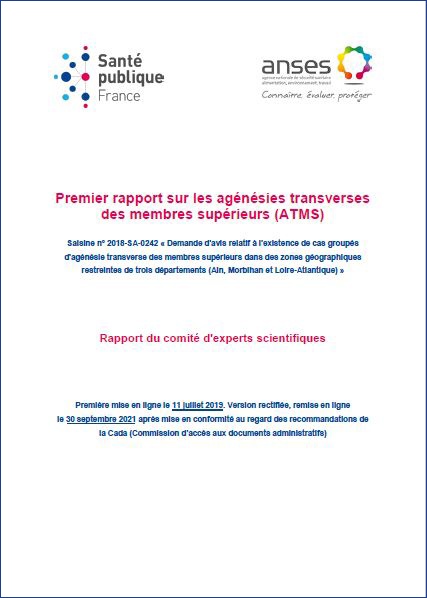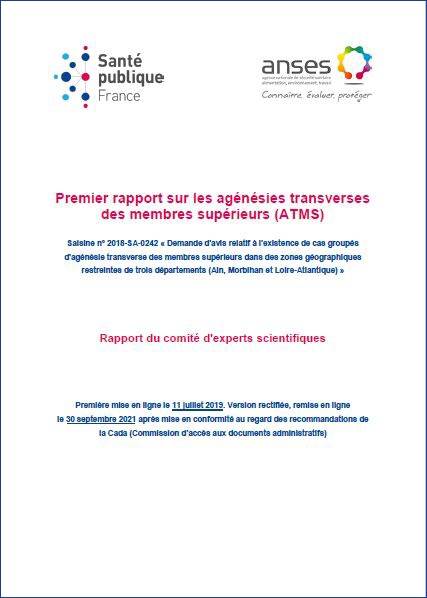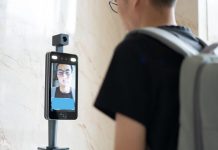
This document is the final version of the first report on ATMS (transverse agenesis of the upper limb) of the Committee of Scientific Experts published on July 11, 2019, rectified and put back online after work to bring it into line with the recommendations of the Cada ( Commission for access to administrative documents). Indeed, as part of the continuous improvement of Public Health France practices and to take into account the advice of the Cada, issued on 02/11/2021, the report was removed from the Public Health France website in the month of May 2021, in order to ensure the absence of any data likely to present a risk of indirect identification. The report was then reassessed and brought into line with Cada’s recommendations. Summary: To answer the questions of families, the ministries responsible for Health, Ecological Transition and Agriculture contacted Public Health France and ANSES in order to set up collective expertise on the causes of these possible grouped cases. , and in particular on the issue of environmental exposure. The collective expert appraisal system, set up by Public Health France and ANSES, made it possible to carry out the work in complete independence and transparency and to involve all the stakeholders. Two committees were thus formed: the committee of scientific experts (CES) which brings together twenty experts from different disciplines and the orientation and monitoring committee (COS) which brings together all the stakeholders concerned by these cases of ATMS, including parents of children affected of this deformity. A collective expertise integrating citizens’ hypotheses The committee of experts has endeavored, in accordance with its mission, to identify and analyze the hypotheses on the causes of these possible grouped cases of Transverse Agenesis of the Upper Limbs. Its work and recommendations have taken into account all available data and all assumptions without exclusion. For this, the CES relied in particular on the questions formulated by the COS as well as on the work carried out by Public Health France and ANSES within the framework of their fields of expertise, and on the data from the registers. To take into account the contributions and expectations of citizens, a temporary reporting system has also been put in place. In total, 143 reports of people with malformations and 43 contributions on hypotheses of possible causes were analyzed and taken into account in the expert appraisal work. A necessity: precisely defining and diagnosing ATMS As a preliminary, the CES endeavored to specify the definition of Transverse Agenesis of the Upper Limb (ATMS). ATMS is a transverse anomaly, affecting only one limb, and isolated, that is to say that no other tissue or organ is involved. Its diagnosis can be difficult because it can be confused with other anomalies of a different nature and of known origins (genetic or mechanical). It is therefore important to ensure that there is no associated malformation(s), even minor, that could lead to another diagnosis. Congenital malformations, including ATMS, remain rare. They represent 3% of births worldwide (ATMs represent 1.7 births per 10,000) and their prevalence rate is globally stable. It is the occurrence of cases grouped in time and space, greater than the expected number, which constitutes a signal that may justify carrying out additional investigations (known as cluster1 or spatio-temporal aggregate in French). The CES deemed it necessary for a group of experts to re-examine all the medical files of children with ATMS reported in Brittany and Ain. This re-examination, which was done anonymously and without geographical affiliation, made it possible to identify that certain reported cases were not ATMS. Based on this review, the CES validated 3 cases of ATMS, in a town in Morbihan (Brittany), born between 2011 and 2013, and confirmed the suspicion of a cluster for these cases. Additional investigations will therefore be carried out in this region to deepen the search for possible common exposures. With regard to Ain, the CES confirmed 6 cases of ATMS between 2011 and 2015 but did not conclude, after statistical analysis, that it was a cluster. For Loire Atlantique, which does not have a register of malformations, the collection and examination of files is in progress. This analysis has therefore shown the importance, in the event of a signal, of an accurate diagnosis of the nature of the congenital malformation. This diagnosis must be made by a medical geneticist in one of the rare disease reference centers labeled for developmental anomalies. Reinforce surveillance and care for the families concerned Following a detailed analysis of the surveillance and alert system for congenital malformations in France, the CES formulates a series of recommendations in order to strengthen surveillance and enable rapid assessment in alert case. In addition to the creation of a seventh register and the implementation of better coordination of registers, the CES recommends relying on the National Health Data System (SNDS) and on health professionals, in particular sonographers and the multidisciplinary centers for prenatal diagnosis, to set up a system for reporting suspicions of grouped cases which covers the whole territory. Whether it concerns ATMS or other congenital malformations, the CES also makes proposals to improve support and listening to the families concerned. Information and training actions for health professionals are also to be developed. Search for possible environmental risk factors: work on an unprecedented scale In order to identify new possible risk factors for these malformations, an in-depth review of the literature was launched by ANSES and Public Health France, which account in particular of citizen assumptions. More than 20,000 scientific articles were selected from keywords validated by the CES. A review of regulated chemicals was also conducted. The work in progress will make it possible to better characterize and prioritize the possible environmental risk factors to be studied as a priority. They will be the subject of a second report. To date, in the absence of identification of risk factors for ATMS and due to the rarity of these malformations, the CES does not recommend carrying out a large-scale epidemiological investigation, which would require several decades. comments. However, the CES considers that knowledge of the environmental causes of developmental anomalies is currently insufficient and recommends strengthening research resources on this subject.
Year of publication: 2021
Pages: 240p.













